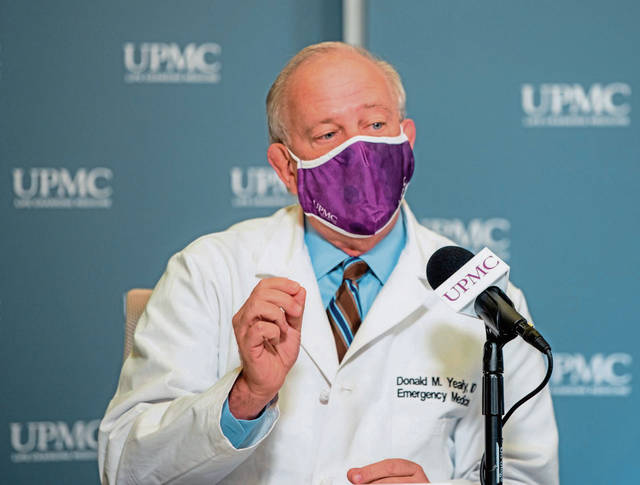What happened to the flu? Mild season in Pittsburgh area could see an uptick, experts say
Flu cases both locally and across Pennsylvania have remained low compared to the record-breaking case counts seen in the 2019-20 flu season. But doctors cautioned Tuesday it’s still early in the season, and the usual January uptick could coincide with a holiday-driven surge in covid-19 cases.
As of Dec. 19, there have been 767 lab-confirmed cases of influenza reported across Pennsylvania. The official surveillance season for influenza begins the 40th week of the year — this season, Sept. 27 — and ends the 20th week of the following year. This season will end May 22.
Across the state, just under 130,000 cases of the flu were confirmed in the 2019-20 season, which ended just as the covid-19 pandemic began taking hold. The influenza count did not include covid-19 cases.
Did masks, distancing help?
“It may be just the anomaly of a flu season, or it may be that the collective efforts to mask and distance and not congregate also have a benefit in influenza transmission — and other viral pathogens,” said Dr. Donald Yealy, chair of emergency medicine at UPMC.
He said it’s too soon to tell what has caused there to be so little flu activity across the state so far this season.
“I wouldn’t declare victory yet,” he said. “In many times, flu season does not begin in earnest until January or even February, so there still is opportunity.”
He said the low flu numbers have played out not just across UPMC, but all of Allegheny County. The county health department reported 35 cases as of Dec. 19.
Last year, during the 2019-20 flu season, there had been 3,141 reported cases as of Dec. 21, 2019.
Increase coming, but by how much?
Dr. Marc Itskowitz, an internal medicine physician with Allegheny Health Network, said there is concern an increase in flu cases in January could come at the same time as an increased surge in covid-19 cases driven by holiday travel and gatherings in the last weeks of December.
He said the surge in case counts can come two or three weeks after the traveling and gathering, and hospitalizations can follow in another two or three weeks.
Yealy said while he can’t predict the timing or severity of any future influenza or covid-19 surges, they are all but a certainty.
“What I am certain of is that there will be more respiratory virus of either one of those in the upcoming weeks,” he said. “The question is how much will it be, and we just don’t know yet.”
There have been no in-patient influenza cases so far this season at any UPMC or AHN facilities.
Few flu cases in Westmoreland, too
Dr. Carol Fox, chief medical officer of Excela Health, said flu activity has been low in Westmoreland County as well, noting there has not been the “usual uptick” in cases that often starts in late November or December.
She, too, said that could be because of the mitigation measures in place to slow the spread of covid-19.
Low case counts mean the state Department of Health has not released a county-by-county breakdown of influenza numbers. Numbers for each county will be released when they’re at a level “that protects the confidentiality of the patients’ health information,” according to the website.
Because of that, the influenza case count was not available for Westmoreland County, which does not have its own county-level health department. The county ended the 2019-20 season with 3,636 confirmed cases.
Itskowitz cautioned against drawing parallels between covid-19 and flu numbers or between the effects of mitigation efforts. The two are not comparable.
“Influenza is just less contagious than covid-19 is,” he said.
He noted most people who contract the flu will have symptoms within one or two days, whereas those who are infected with covid-19 might not show symptoms for up to two weeks — if they show them at all. That dramatically lowers the opportunities for asymptomatic and presymptomatic spread, he said.
Flu deaths: 102 vs. covid: 15,300
In the 26 weeks that made up the 2019-20 flu season — Sept. 29 to March 28 — Pennsylvania saw 102 flu-related deaths. In the nearly 43 weeks since the first case of covid-19 was diagnosed in Pennsylvania, more than 15,300 people have died from the virus across the state.
There are no previous numbers with which to compare covid-19 cases, and Yealy said to even compare the two viruses beyond the very surface is disingenuous.
“What’s similar about the two is they’re both spread by close contact and they’re both respiratory viruses,” he said, noting that’s where the comparables stop. “Yes, the flu kills many. This (covid-19) is associated with even more death and hardship.
“To just say ‘it’s the flu’ is really a dramatic understatement. And it’s not an excuse not to do the right things.”
Remove the ads from your TribLIVE reading experience but still support the journalists who create the content with TribLIVE Ad-Free.

